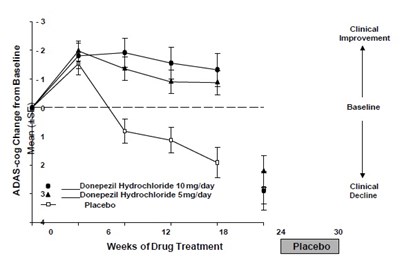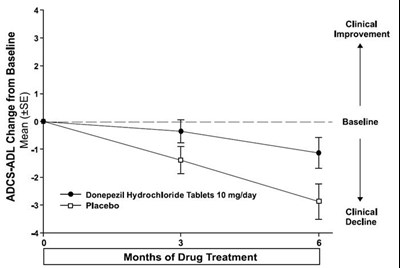Product Images Donepezil Hydrochloride
View Photos of Packaging, Labels & Appearance
Product Label Images
The following 16 images provide visual information about the product associated with Donepezil Hydrochloride NDC 60429-322 by Golden State Medical Supply, Inc., such as packaging, labeling, and the appearance of the drug itself. This resource could be helpful for medical professionals, pharmacists, and patients seeking to verify medication information and ensure they have the correct product.
60429 321 30LB

Each tablet contains 5 mg of donepezil hydrochloride, USP. Details about dosage can be found in the accompanying Prescribing Information. It should be dispensed in a tight container with a child-resistant closure. The medication should be kept out of reach of children, and the pharmacist should dispense Patient Information to each patient. The tablets should be stored between 20°C-25°C and excursions permitted to 15°C-30°C. Manufactured by ScieGen Pharmaceuticals and marketed by GSMS Incorporated. This is Rx only medication.*
60429 322 30LB

This is a description for Donepezil Hydrochloride Tablets, USP. It gives instructions on dosage and how to store the medication. It recommends to keep it in a tight container with a child-resistant closure and away from the reach of children. The pharmacist is advised to dispense patient information to each patient. The medication is manufactured by ScieGen Pharmaceuticals, Inc. and marketed by GSMS, Incorporated. A link for printing patient information is also provided.*
3 - Donepezil figure 02

This is a clinical study comparing the effects of Donepezil Hydrochloride 10mg/day, Donepezil Hydrochloride 5mg/day, and a placebo on cognitive decline. The study lasted for 8 weeks of drug treatment. There was clinical improvement in the group taking Donepezil Hydrochloride 10mg/day compared to baseline, while there was a decline in the placebo group. The text lacks complete information to provide a broader picture of the study.*
4 - Donepezil figure 03

This appears to be a table showing results of a study evaluating a treatment's effect on cognitive function. The treatment group and placebo group are compared based on the change in a cognitive measure called ADAS cog. The table also shows the percentage of participants in each group that experienced certain levels of improvement or decline. The dosages of the treatment are listed as 2.5mg/day and 10mg/day. The numbers at the bottom appear to indicate the range of change from baseline in the cognitive measure.*
5 - Donepezil figure 04

This is a table showing the percentage of patients who took Donepezil Hydrochloride at different doses and a placebo, with their corresponding changes in CIBIC-plus rating. Not enough information is provided to give more context.*
8 - Donepezil figure 07

This is a graph displaying the percentage of patients taking different dosages of Donepezil Hydrochloride and Placebo, based on their improvement after treatment. The CIBIC-plus Rating is also mentioned.*
9 - Donepezil figure 08

This appears to be a graph or chart showing the mean change from baseline in clinical improvement and decline for patients taking donepezil hydrochloride 10mg/day compared to placebo over a period of 3 months of drug treatment. No further information is available in the provided text.*
10 - Donepezil figure 09

The text describes a graph that shows the cumulative percentage of patients based on treatment with Donepezil Hydrochloride 10 mg/day or Placebo. The graph also indicates the SIB (Severe Impairment Battery) Change from Baseline over the course of 75 days.*
11 - Donepezil figure 10

This appears to be a graph depicting the change from baseline in ADCS-ADL score over three months of drug treatment with Donepezil Hydrochloride Tablets 10mg/day and placebo. The graph shows two lines, one representing clinical improvement and the other representing clinical decline, with the x-axis indicating the months of drug treatment and the y-axis indicating the mean (+SE) change from baseline.*
18 - Donepezil figure 11

The text presents a graph showing the cumulative percentage of patients in relation to the ADCS-ADL Change from Baseline, comparing the results between the Donepezil Hydrochloride 1mg/day treatment and a placebo. It indicates that at the 5% change from baseline, Donepezil Hydrochloride appears to have a stronger effect in improving patients' conditions than the Placebo treatment.*
19 - Donepezil figure 12

This text represents a clinical study comparing the efficacy of Donepezil Hydrochloride at doses of 10mg/day and 23mg/day. The study reports a 3% improvement over a period of 18 weeks in an unspecified condition. The graph appears to show the improvement over time.*
20 - Donepezil figure 13

This appears to be a graph reflecting the cumulative percentage of patients who had a change in SIB (Severe Impairment Battery) scores from baseline after being treated with Donepezil Hydrochloride 10mg or 23mg. The graph shows the percentage of patients on the y-axis, and the change in SIB from baseline on the x-axis.*
Donepezil figure 14

The text appears to be a table displaying data related to "Donepezil Hydrochloride Tablets" and "CIBIC-plus Rating". Therefore, it can be described as a chart showing the percentage of patients with different levels of improvement after taking 10mg/day and 23mg/day of Donepezil Hydrochloride Tablets. The table also shows the CIBIC-plus Rating scale, which ranges from "Markedly Improved" to "Markedly Worse".*
* The product label images have been analyzed using a combination of traditional computing and machine learning techniques. It should be noted that the descriptions provided may not be entirely accurate as they are experimental in nature. Use the information in this page at your own discretion and risk.


